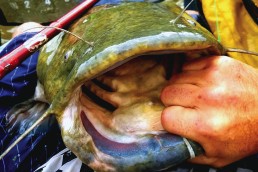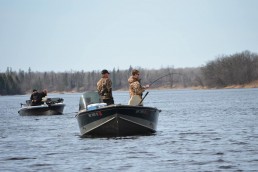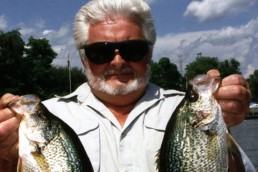Flathead Catfish: The King of Freshwater Sport Fish?
SHARE THIS POST
I used to catch flatheads by mistake. Now I spend countless hours fishing for them in earnest. There’s something mysterious about anchoring up ahead of a deadfall on the mighty Mississippi and waiting for a 50-pound fish to grab your line. That pole becomes electric, the reel squeals as you frantically try to pull that monster out before she snags up in that massive snag, and then, the fight really begins.
You’re up against a 4-mph current. You’re hoping your knots hold and that the beast doesn’t snag the motor, anchor line and other rods. Finally, you wonder how the heck you get it in the net by yourself. Forget the net—the fish will bust it anyway. It’s “grabbin’ time.” You grab him in the mouth and hope you don’t get sliced. This is big-boy fishing.
Flathead catfish are at the top of the freshwater food chain. With a mouth the size of a folded over large pizza, these can inhale panfish, rough fish and gamefish with ease. They’re also camouflaged and stick near the bottom at ambush points in constant search of their next meal.
Once hooked, they’ll put up a great battle; they should be as revered as the mighty muskie. As more and more catfishing tournaments turn up across the nation, anglers have begun to realize what great sport and attraction the catfish has.
The search for the trophy flatheads begins with fresh bait. While I’ve caught my fair share of flatheads on cut baits, worms and crankbaits, a good, hearty live fish on the end of the hook is your best bet. The preferred bait is usually what is available on the lake or river you’re fishing. Bait shops can provide you with live suckers or large shiner minnows in many areas.
In most states, you can catch your own bait with a throw net, seine or hook and line. I’m a hook-and-line guy, and on the rivers that I fish in Iowa and Illinois, I’ll catch bluegills and perch to use as bait. A light panfish rod, some ice jigs and either waxworms or red worms, will usually allow me to tank a few panfish for the day or night adventure. If I’m in the boat, the bait just goes in the livewell. When fishing from shore, I tote along an aerated minnow bucket too because it’s important the bait remains alive. In areas farther south, skipjack herring is the preferred bait, which can be readily caught below dams using Custom Jigs & Spins Slender Spoons or Flu Flu Jigs.
The setup is simple, but the approach needs to be exact. Veteran Kansas angler Warren “Catman” Boseker fishes from shore, from his boat and sometimes a float. He’ll fish for big flatheads below dams where catfish prey is plentiful. Shore fishing below a dam requires a long rod of at least 8 feet to cast to a distance and to be able to horse those fish in with the heavy current. Other popular shore spots are around fallen trees with deep water nearby.
The classic flathead-river spot is just upstream of a deadfall. Ideally, you want deep water nearby and an even deeper hole under the deadfall. Other spots are below dams and in river bends that hold deeper water along with the flats above them. Larger piers will also hold cats as well as any ambush-type areas that look “fishy.”
Anchoring is important, and in my boat I employ the two-anchor method where I dump one off the bow and allow the boat to drift down to the right spot—above the deadfall—before tying it off. Then a second, smaller anchor is dropped straight down and tied off the stern. This keeps the boat from swinging side to side when the wind whips up. During the day I’ll cast right up to the deadfall and allow the bait to sink right under the trees. In the daytime the catfish will hole up under the deadfall. The sound of the baits splashing the water, followed by the smells and vibrations of the struggling baits, draws in the flatheads like a magnet.
One Rippin Lips pro staffer is a flathead expert and points out, “Right now, the water temperatures are climbing and flatheads are making their transition into feeding on mostly live baits that are a native forage to the area you happen to be fishing.”
He says his favorites are hand-sized bluegills, big chubs and 8- to 10-inch shad. During the daylight hours he says you should look for flatheads tight to cover.
Are you enjoying this post?
You can be among the first to get the latest info on where to go, what to use and how to use it!
“I target mainly wood in water that has adequate depth.”
He adds that flatheads aren’t particularly fond of high current, so you should seek out cover near current breaks and seams. At night, flatheads move onto shallow flats to seek out food. He says the best flats are those that have wood cover and good depth and are just adjacent to them.
“I often catch 40- to 60-pound fish in flats from 1 to 5 feet deep.”
He says a large flathead will often have a subtle bite.
“Don’t jump the gun, especially with circle hooks. Wait for a steady bend in the rod, reel down, and 90 percent of the time he’s hooked.”
The tackle needs to be stout to handle the larger cats.
“I use some that I’ve helped design for Rippin Lips Tackle. Their SuperCat rods are the toughest I’ve found for flathead fishing.”
He said the 7-foot 6-inch, medium-heavy rod is ideal for flathead situations and is favored by Mike Paul.
Most serious shore anglers like Warren choose the 8-foot, heavy-action rod to horse the fish out of the rough areas. Shore anglers also like the 10- and 12-foot SuperCat to cast to farther distances around dams.
Mike Paul designed the NeverSnag anchor to hold the boat in the swiftest currents. It’s a claw anchor with a chain held in place with a foolproof release system. It grips immediately, and if it becomes stuck, when you pull it straight your anchor pulls right out. Paul has four models available and I use the GrabLite model on my 17-foot Lund.
Ming Yang/Rippin Lips makes two baitcasting reels designed specifically for catfish and other large freshwater and saltwater fish: the MC500 and MC600. These are stainless steel, aluminum, have brass construction and are built to handle large fish. Spool them up with 50- or 80-pound-test SuperCat braid for a winning combination. Finally, for hooks, use Rippin Lips’ Tournament Grade Circle Hooks in 5/0, 7/0 and 8/0.
MWO
SHARE THIS POST
Did you enjoy this post?
You can be among the first to get the latest info on where to go, what to use and how to use it!
Walt Matan
Walt Matan has been a writer and television host for MidWest Outdoors for 30 years. An avid ice and open-water fisherman, he currently lives in the Quad Cities on the shores of the Mississippi River. He is the product developer and brand manager for Custom Jigs & Spins, B-Fish-N Tackle, and Rippin Lips Catfish Tackle. For more information visit customjigs.com.



